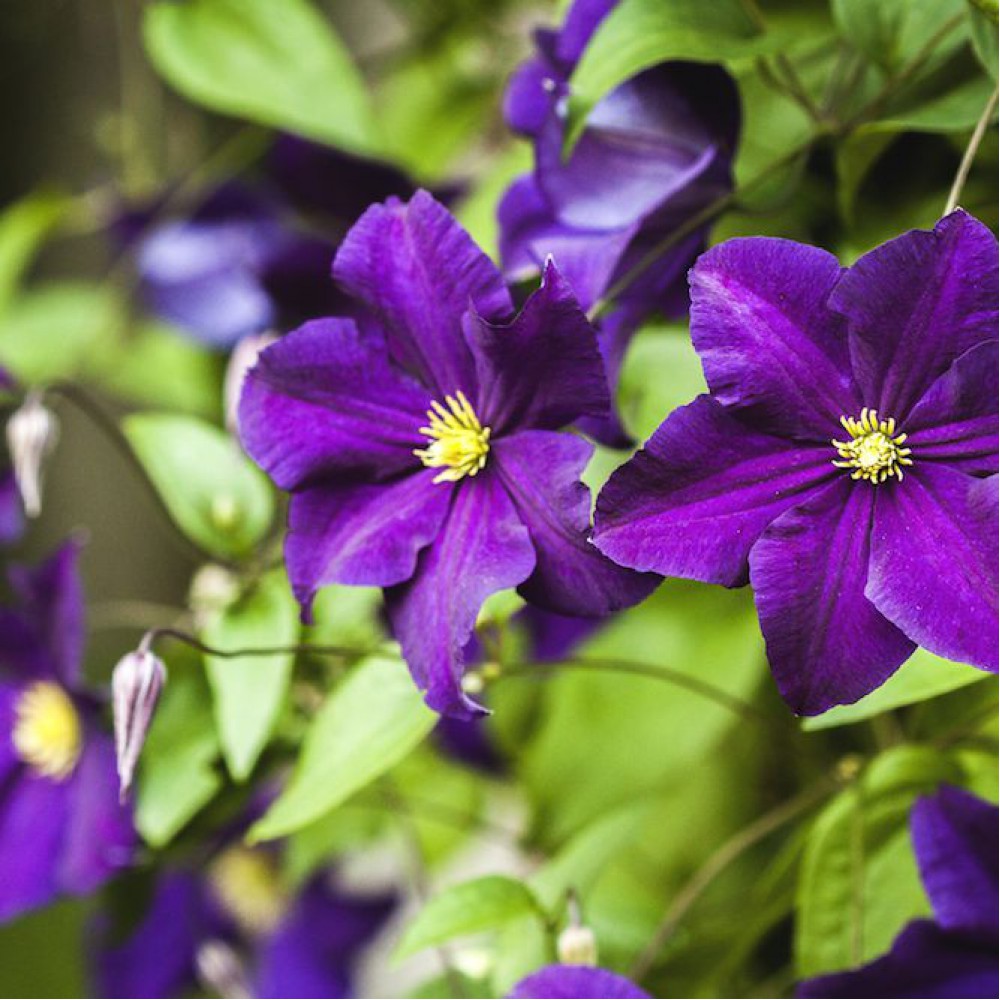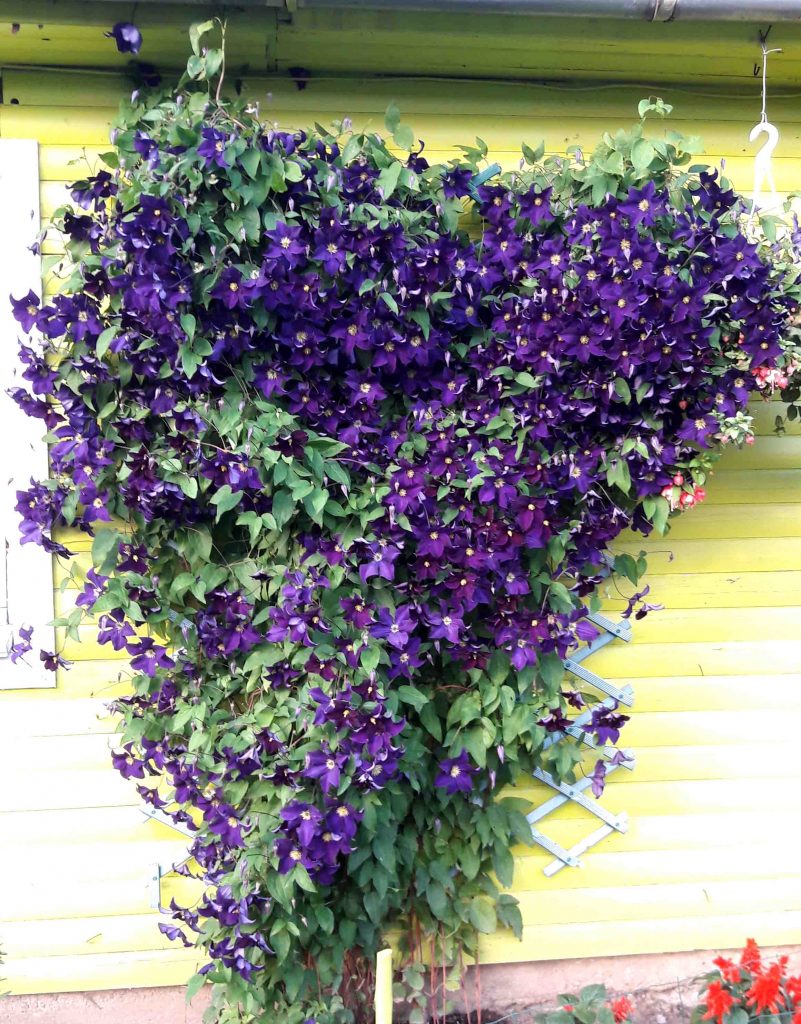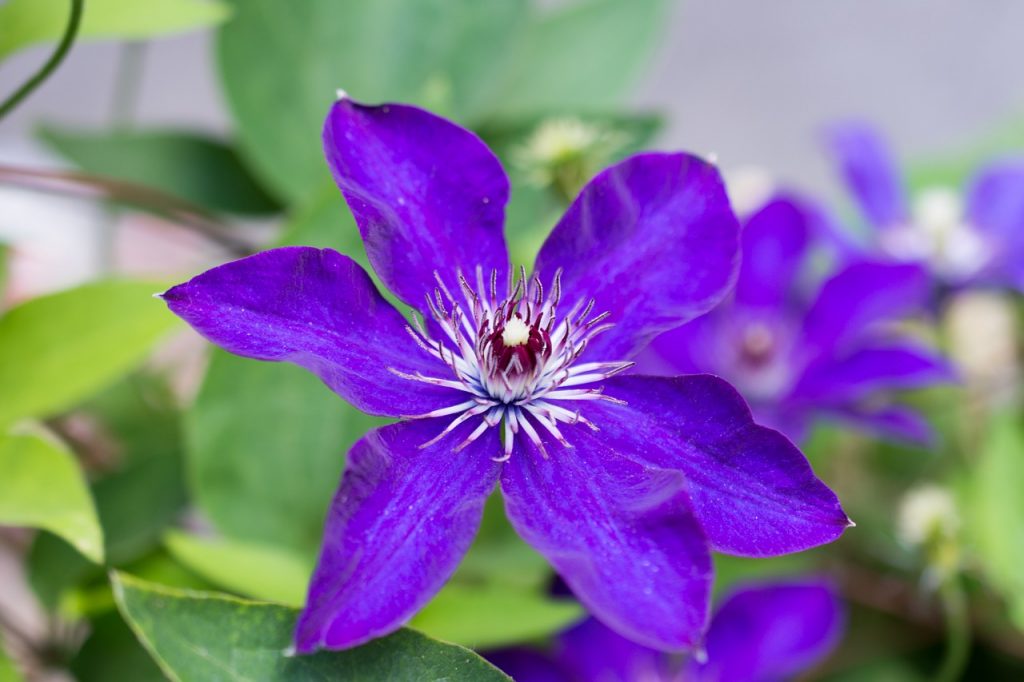Clematis Viola is a popular bright variety
Clematis Viola is an ornamental perennial from the Buttercup family. This variety was bred in Estonia in 1983 on the basis of Lord Neville variety (originator - U. Kivistik). The perennial vine is still popular among gardeners due to its beautiful bright flowers, unpretentiousness and easy care.

Clematis viola photo and description
Description of the variety
Viola is a perennial clematis with curly shoots that can trail upward along the support. The liana reaches 2-3 m in length.It has small trifoliate leaves and large disc-shaped flowers with a diameter of 10-14 cm.
Petals - double, deep purple with purple veins and a pointed edge (6 pcs). The middle with anthers is light yellow.
This variety pleases with abundant flowering almost all summer - from the second decade of June to the end of August. Flowers appear on the shoots of the current year.
Landing features
Clematis is best planted in light partial shade, since the flowers can fade in the sun. The ideal spot is well lit in the morning and evening, but tucked in at noon. Perennial prefers fertile, drained soils with a neutral, slightly acidic or slightly alkaline reaction.

Clematis viola description
It is advisable to plant the vine in a windless or wind-protected area. If planting is carried out against the wall, the distance to the seedling should be at least 50 cm (so that rainwater does not flow down onto the plant from the roof). The best exposure for clematis is east or west.
Viola can be planted in spring (at the beginning of the growing season) or early autumn.
Technology:
- Dig a hole to a depth of 70 cm (and with the same diameter).
- If the groundwater is located close to the surface, drainage from broken brick or crushed stone is laid on the bottom.
- Garden soil is mixed with peat and compost, 60-70 g of superphosphate is added.
- The substrate is poured in a slide into the center of the planting pit.
- Place the plant, spreading its roots over a mound.
- Fall asleep with the remnants of the soil mixture (annual clematis are deepened by 1 knot, older ones - by 2-3 knots), tamped, watered, mulched.
- A support is installed and the shoots are tied up.
Care
Variety Viola - does not belong to picky plants, and caring for it is not particularly difficult. He needs the correct regime of watering and feeding, as well as annual pruning.
Mulching the soil will ease the work of the gardener, protect the roots from overheating and reduce moisture evaporation.
Watering
In the first season after planting, clematis is watered several times a week, moderately moistening the soil. The moisture should reach the roots, but not turn the earth into a swamp. In the future, watering is done weekly, using 2 buckets of water per bush.
Top dressing
In the first year, Viola does not need to be fed - the fertilizers laid down during planting will be enough for her. In the next season, feeding is carried out 2 times a month, alternating organic compounds (compost, rotted manure) with mineral complexes.

Clematis viola reviews
It is useful to sprinkle the soil with wood ash (1 glass per bush), which will not only add nutrients, but also create disease prevention.
Autumn pruning and preparation for winter
Viola belongs to the third group of pruning. Since flowers grow only on the shoots of the current year, the bush is cut off thoroughly, leaving 2-3 nodes from the surface of the ground. This allows you not to cover it for the winter, but only to mulch with a thick layer of peat or sawdust.
Diseases and pests
| Problem | Symptoms | Prophylaxis | Treatment |
| Nematode | Leaves are deformed and stained, stems dry out, roots darken and die off. | Disinfection of garden tools, soil, drainage material. Purchase of healthy seedlings. Do not overheat the soil. | Cut off the affected parts of the plant. Treat the remaining cuttings with nematicides and root in a new place. |
| Rot | The bush withers, stops growing. The leaves fall off, the stems darken and soften. | Moderate watering, disinfection of tools, preventive spraying with Bordeaux liquid. | Remove damaged parts, sprinkle with crushed charcoal or other antiseptic. Treat with fungicides (Trichodermin, Mikosan, Topaz). |
| Fusarium | The leaves become lethargic, covered with brown spots. | Cut off the stems at the very base, burn the fallen leaves and cut shoots. Treat the bush with Previkur. |
Testimonials
Due to its unpretentiousness and resistance to frost, Clematis Viola is popular among flower growers in Russia and neighboring countries. It is often used for vertical decoration of gardens, courtyards, areas. A weaving liana with large and bright flowers decorates walls, gazebos, pillars, mesh fences. Gardeners note that the iron fence is an unfortunate neighborhood for her, since the metal becomes very hot in the summer heat.

Clematis viola photo
Judging by the reviews, Viola looks most impressive against a light background of plants. It is sometimes used as a ground cover crop. It is noticed that the perennial planted on the northern side of the site blooms less abundantly. However, regular feeding can improve its decorative effect.

